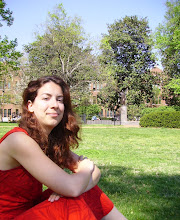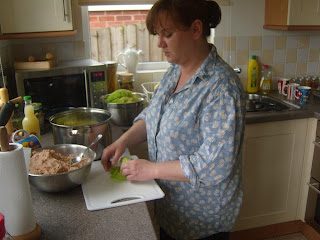 ds like somebody speaking 'posh', but with a bit of an Australian accent thrown in.
ds like somebody speaking 'posh', but with a bit of an Australian accent thrown in.He loves to eat and to cook, and tonight is my lucky night: time for a feast. We've spent many a happy moment in preparation discussing Singaporean cuisine and its similarities to Chinese and Indonesian/Malay cooking (with which I am more familiar).
Though it is 'only' a city state, Singapore has almost 5 million inhabitants and is one of the most densely populated nations on earth. Before meeting Des, I had already read a very enthusiastic article about the world famous 'hawker centres' which seem to bring together specialists of various dishes in hygienic-but-authentic outdoor or indoor conglomerations of foodstalls. Some people seem to visit Singapore only for the food! Sadly, I've only been airport for a stopover...
In preparation, Derek has bought bagloads of ingredients at the local Chinese store in Oxford...this is a great shop that I enjoy wandering around in a mildly perplexed state. One day I came home with paper money that had "Bank of Hell" printed on it...so called Hell Money, used to provide d
 ead ancestors with cash for the afterlife. I also saw a guy in front of me in the queue with a 2 kg bag of frozen chicken feet, hard to get at the local Sainsbury's. Derek shows me some packages that say "Dried Provisions" on them as the only indication of what can be found inside (for those who cannot read Chinese script). Luckily he is a man with a plan and gets to preparing the feast for me and his flatmate. All I need to do is watch and chop the occasional vegetable.
ead ancestors with cash for the afterlife. I also saw a guy in front of me in the queue with a 2 kg bag of frozen chicken feet, hard to get at the local Sainsbury's. Derek shows me some packages that say "Dried Provisions" on them as the only indication of what can be found inside (for those who cannot read Chinese script). Luckily he is a man with a plan and gets to preparing the feast for me and his flatmate. All I need to do is watch and chop the occasional vegetable.To start, I am served bak kut teh soup with bean sprouts, mince-meat and salted vegetables. These were served with steamed char siu buns (pictured at left). This is the only part of the meal that I have easily recreated at home...as all it involves is buying the fro
 zen buns and steaming them above hot water for ten minutes. I love the sweet and savoury taste of the pork filling.
zen buns and steaming them above hot water for ten minutes. I love the sweet and savoury taste of the pork filling.The main course consists of an authentic dish of stir-fried kailan and cloud-ear fungus with baby corn an
 d oyster sauce. Kailan is otherwise known as 'Chinese broccoli' or 'Chinese kale'. I would say it's more like kale than broccoli, see right. The cloud-ear fungus was one of the 'Dried Provisions'. When fresh...they supposedly resemble human ears. Not sure where the clouds come in.
d oyster sauce. Kailan is otherwise known as 'Chinese broccoli' or 'Chinese kale'. I would say it's more like kale than broccoli, see right. The cloud-ear fungus was one of the 'Dried Provisions'. When fresh...they supposedly resemble human ears. Not sure where the clouds come in.The final savoury dish is prawn laksa noodles served with fried onions and hard-boiled eggs.
I am absolutely stuffed and need to give everything some time to digest before having any space for desert. Desert is more of a 'fusion' dish, lovely vanilla ice cream with lychee and raspberries.
You can understand why this meal deserves the epithet 'feast' as with so many dishes, it is difficult to chose the one most representative for the whole meal. I think I'll need to travel to Singapore sometime in the near future and venture outside of the airport, but in the meantime hope to entice Derek to teach me more about this cuisine (=cook for me) while we're both still in Oxford.





















